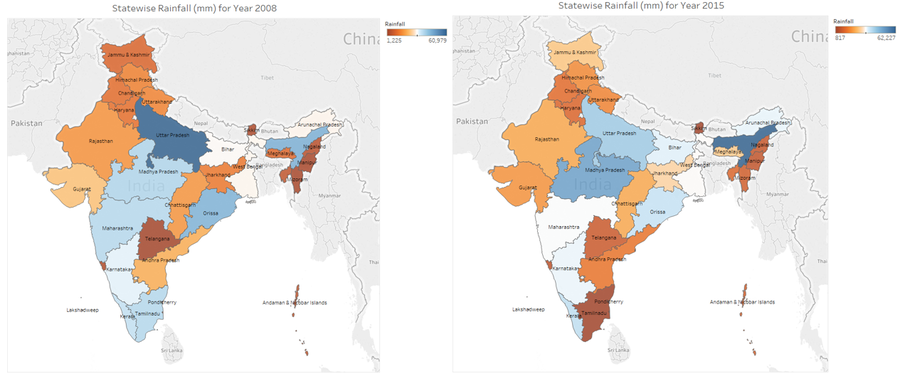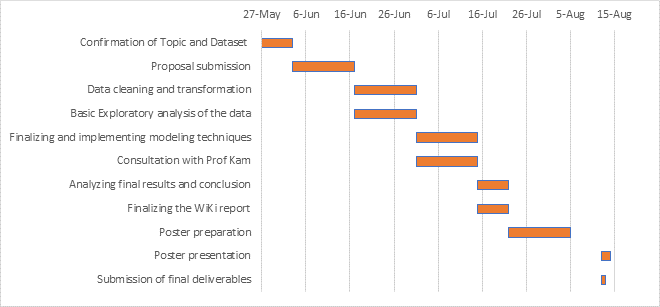Difference between revisions of "Group04 Proposal"
| Line 85: | Line 85: | ||
| <div style="font-family:Century Gothic; border-radius: 1px "> | | <div style="font-family:Century Gothic; border-radius: 1px "> | ||
| − | + | As stated above, the objective of this project is to analyze the rainfall pattern changes in India and to find out how it is affecting India’s overall agricultural production. | |
<br/> | <br/> | ||
Revision as of 16:35, 17 August 2018
Water For Life: Effect Of Rainfall On India's Crop Productivity
|
|
|
|
|
|
|
Contents
Introduction
Climate change has a serious impact on the availability of various resources on the earth especially water, which sustains life on this planet. One occupation that has experienced a direct impact due to these increasing climate fluctuations is Agriculture. Especially in a country like India where water, the most critical agricultural input is scarce. Nearly 55% of the total cultivated areas in India do not have irrigation facilities. And hence Indian farmers are highly dependent on rainfall as rainfall is the fundamental driver of water availability for agriculture. Changes in precipitation affect the quality and quantity of the agriculture produce in direct proportions of the rainfall received. In this study, we intend to analyse India’s rainfall pattern for past few years using various exploratory techniques, primarily focusing on apt visualizations to reveal the undiscovered truth. Over 80% of the annual rainfall is received in the four rainy months of June to September. There is great regional and temporal variation in the distribution of rainfall and although the monsoons affect most parts of India, the amount of rainfall varies from heavy to scanty on different parts. The primary motive of our analysis is to scrutinize the effect of irregularities in the rainfall pattern on agricultural productivity in India. Through our analysis, we would like to derive meaningful insights that foster our understanding about the most affected regions and crops because of the variability in climactic changes. This analysis can then be further utilized be relevant departments in Indian Government to devise national & regional long-term strategies for sustainable development.
|
Inspiration
In India, average food consumption at present is 550 g per capita per day. With the growing population, the imminent challenge is to increase food production in order to feed the population that will reach 1.30 Billion by the year 2020. Farmers will have to produce 50% of more grains to meet the current growing demand. India is home to 17% of the world population, but only 4% of the world water resources. India has experienced 23 large scale droughts starting from 1891 to 2009.
A new study suggests that India will see more erratic whether events in the coming years bringing more drought and more storms. Additionally, with the increase in global warming, the longevity of heat waves across India is all set to increase with warmer night temperatures. The days are getting hotter and this trend is only expected to continue. With every 1 degree rise in temperature, wheat yields are predicted to fall by 5-10%. India could experience a 40% decline in in its agricultural productivity by the year 2080. Climate change is posing a massive threat to agriculture and food security in India.
All these factors make it vitally important to study historical data to understand future better. This analysis is an honest endeavour in gaining deeper knowledge into the impact of increasingly changing weather trends so that we can be prepared to mitigate the risk of these uncontrollable factors and seek remedies that would help sustain such drastic natural phenomenon.
|
Key Objectives
About The Dataset
| Data | Format | Source |
|---|---|---|
| Monthly & Annual Rainfall Precipitation For 34 Indian Meteorological Subdivisions | xls | http://www.tropmet.res.in/~lip/Publication/RR-pdf/RR-138.pdf |
| District-wise & Season-wise Crop Production | xls | https://data.gov.in/catalog/district-wise-season-wise-crop-production-statistics |
| Shapefile For 36 Indian Meteorological Subdivisions | GIS (shp, shx) | https://groups.google.com/forum/#!topic/datameet/12L5jtjUKhI |
Key Milestones
Expected Challenges
1. Data collection – we are still in the process of data collection. We are collecting data from various sources and will be integrating it together before analysis. 2. Steep learning curve – there is a steep learning curve involved in working with R-Shiny, SAS JMP Pro and Tableau. 3. Correlation between rainfall pattern and farmer’s suicide – Even though it is apparent that changes in the rainfall pattern over past few years affecting agriculture industry in India and increasing farmer’s worries, discovering direct correlation between rainfall pattern and farmer’s suicide is challenging.
|


